八年级下册英语Unit 1 What's the matter 教案
- 格式:doc
- 大小:110.55 KB
- 文档页数:28
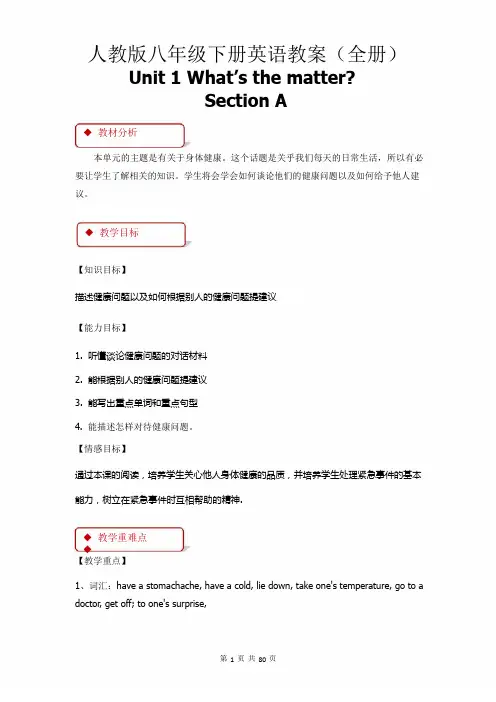
人教版八年级下册英语教案(全册)Unit1What’s the matter?Section A◆教材分析本单元的主题是有关于身体健康。
这个话题是关乎我们每天的日常生活,所以有必要让学生了解相关的知识。
学生将会学会如何谈论他们的健康问题以及如何给予他人建议。
◆教学目标【知识目标】描述健康问题以及如何根据别人的健康问题提建议【能力目标】1.听懂谈论健康问题的对话材料2.能根据别人的健康问题提建议3.能写出重点单词和重点句型4.能描述怎样对待健康问题。
【情感目标】通过本课的阅读,培养学生关心他人身体健康的品质,并培养学生处理紧急事件的基本能力,树立在紧急事件时互相帮助的精神.◆教学重难点◆【教学重点】1、词汇:have a stomachache,have a cold,lie down,take one's temperature,go to a doctor,get off;to one's surprise,2、句型:1.——What's the matter?——I have a stomachache.You shouldn't eat so much next time.2.——What's the matter with Ben?——He hurt himself.He has a sore back.——He should lie down and rest.【教学难点】掌握情态动词should shouldn't.的用法;学习have的用法◆课前准备◆Multimedia,group work,cooperative discussion.◆教学过程Step1.Warm up1.Look at the picture and learn the parts of the body.2.New words and phrases.Step2Presentation1.1aLook at the picture.Write the correct letter[a-m]for each part of the body.Then check the answers.2.1bFirst,lead Ss to read the five names.Then look at the picture.Number the names1-5.’sFinally, check the answers.3. 1cDivide two Ss into a pair to make conversations. Finally, invite several pairs to act outfor the class.Step 3 Practice1. 2aTell Ss there are five conversations. In each conversation the person says what goingon with them. Listen carefully and number the pictures.Play the tape. Then check the answers.2. 2bAsk Ss to listen to the recording again to match the problems with the advice.Play the recording again. Then check the answers.3. 2cAsk Ss to make conversations using the information in 2a and2b. Give them enoughtime to do this task. Later , invite several pairs to present their conversations to theclass.Step 4 Consolidation1. 2dFirst, ask Ss to have a fast reading of the conversation to get the main idea.Then, lead Ss to read the conversation sentence by sentence, explain some languagepoints.Finally, divide Ss into pairs to practice role-playing the conversation.2. 3aFirst, read the passage quickly and answer the question.Then,lead Ss to read the passage and analyse the key points.Finally,read together.3.3bRead the passage again and check the things that happened in the story3cDiscuss the questions with a partner.4.Grammar focusFirst,lead Ss to read the sentences.Then,prompt Ss to analyse the use of model verb should.After that,explain the grammar together.5.4aAsk Ss to fill in the blanks.Then,invite some Ss to present their answers.6.4bAsk Ss to circle the best advice for these health problems,then add their own advice.After that,invite some Ss to present their advice.7.4cOne student mimes a problem.The other students in your group guess the problem and give advice.Step5Language pointsStep6HomeworkMake a conversation about health problems and giving advice.Unit1What’s the matter?Section B◆教材分析本单元的主题是有关于身体健康。
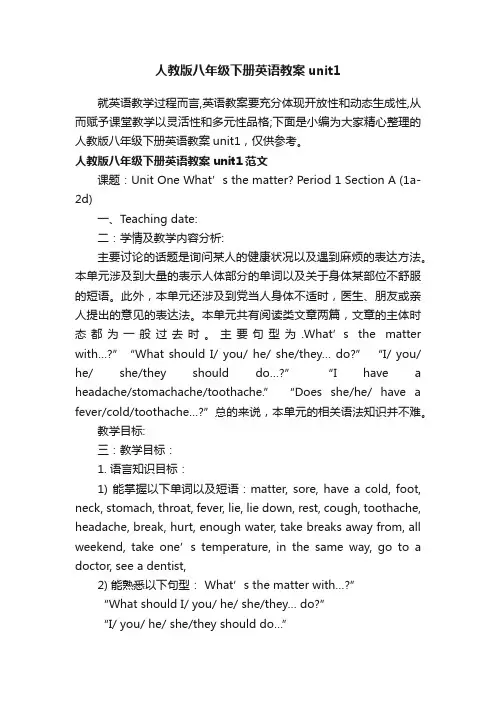
人教版八年级下册英语教案unit1就英语教学过程而言,英语教案要充分体现开放性和动态生成性,从而赋予课堂教学以灵活性和多元性品格;下面是小编为大家精心整理的人教版八年级下册英语教案unit1,仅供参考。
人教版八年级下册英语教案unit1范文课题:Unit One What’s the matter? Period 1 Section A (1a-2d)一、Teaching date:二:学情及教学内容分析:主要讨论的话题是询问某人的健康状况以及遇到麻烦的表达方法。
本单元涉及到大量的表示人体部分的单词以及关于身体某部位不舒服的短语。
此外,本单元还涉及到党当人身体不适时,医生、朋友或亲人提出的意见的表达法。
本单元共有阅读类文章两篇,文章的主体时态都为一般过去时。
主要句型为.What’s the matter with…?”“What should I/ you/ he/ she/they… do?” “I/ you/ he/ she/they should do…?” “I have a headache/stomachache/toothache.” “Does she/he/ have a fever/cold/toothache…?”总的来说,本单元的相关语法知识并不难。
教学目标:三:教学目标:1. 语言知识目标:1) 能掌握以下单词以及短语:matter, sore, have a cold, foot, neck, stomach, throat, fever, lie, lie down, rest, cough, toothache, headache, break, hurt, enough water, take breaks away from, all weekend, take one’s temperature, in the same way, go to a doctor, see a dentist,2) 能熟悉以下句型:What’s the matter with…?”“What should I/ you/ he/ she/they… do?”“I/ you/ he/ she/they should do…”2. 情感态度价值观目标:教会学生关心他人,培养同学间团结、友善的精神。

Unit 1 What's the matter年级八学科英语课型新授课时间主备人八年级英语组教学课题Unit 1 What’s the matter?Section A (1a~2d)课时 1教学目标1. 学习用英语表达身体各部位的名称及如何谈论身体健康状况。
2. 培养学生能运用所学语言简单地描述自己的健康状况及如何询问对方的身体健康状况。
3. 通过学习课文内容,养成健康的生活方式。
4. 教育学生学会关心他人,通过询问他人的健康情况并能给予帮助,增进人与人之间的感情。
重点难点教学重点:1.掌握情态动词should / shouldn’t.的用法.2.学习have的用法.教学难点:学会提供帮助的基本句型教学准备PPT教学过程1、新课导入:Step1: Can you name the parts of the body?让学生用英语所处器官名称。
Step2:Follow me:(让学生站起来完成韵律操)Everybody moves your bodyNod your head and touch your faceTouch your nose and close your eyesTouch your ears and clap your handsRaise your arms and look at your backTouch your stomach and tap your footSit down and move your legs2、设问导读:二次备课4. 如果你的头和脖子明天仍然疼的话,请去看医生。
五.拓展探究Homework: Make up a conversation between a doctor and a patient.课堂小结本课通过身体器官韵律操导入课时内容,激发学生的学习兴趣,提高课堂教学的效率,同时针对学生日常生活中的常见症状,让学生在列举过程中掌握患病方式的三种表达方式。
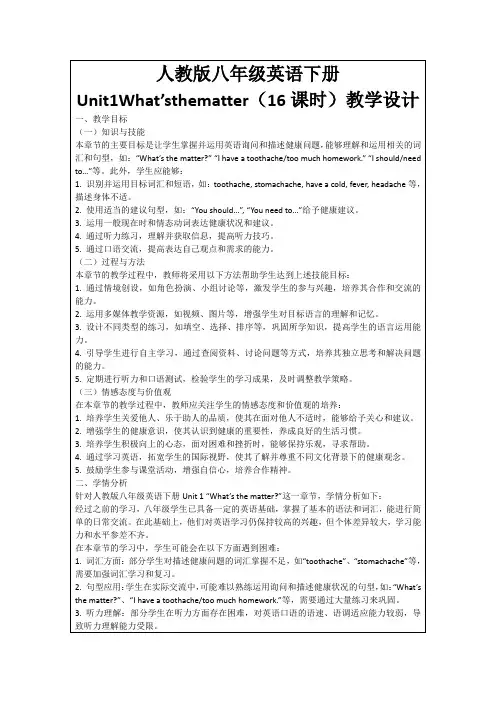
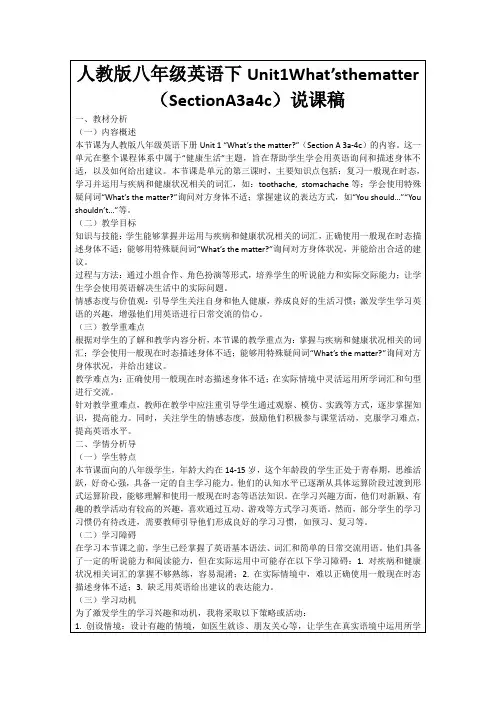
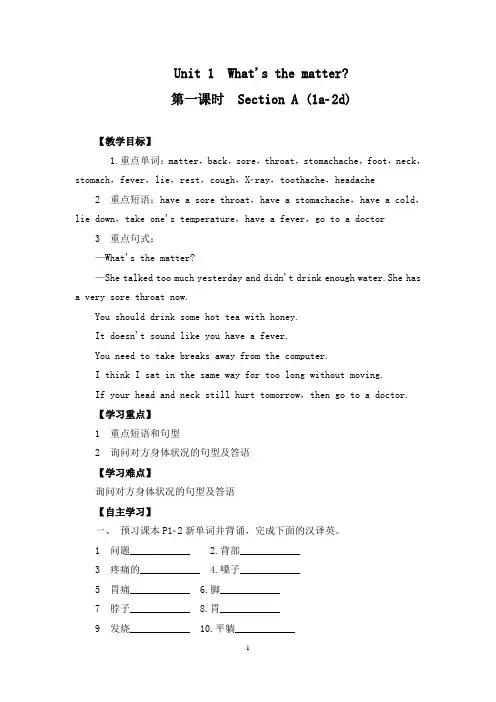
Unit 1 What's the matter?第一课时Section A (1a2d)【教学目标】1.重点单词:matter,back,sore,throat,stomachache,foot,neck,stomach,fever,lie,rest,cough,Xray,toothache,headache2 重点短语:have a sore throat,have a stomachache,have a cold,lie down,take one's temperature,have a fever,go to a doctor3 重点句式:—What's the matter?—She talked too much yesterday and didn't drink enough water.She has a very sore throat now.You should drink some hot tea with honey.It doesn't sound like you have a fever.You need to take breaks away from the computer.I think I sat in the same way for too long without moving.If your head and neck still hurt tomorrow,then go to a doctor.【学习重点】1 重点短语和句型2 询问对方身体状况的句型及答语【学习难点】询问对方身体状况的句型及答语【自主学习】一、预习课本P12新单词并背诵,完成下面的汉译英。
1 问题____________ 2.背部____________3 疼痛的____________ 4.嗓子____________5 胃痛____________ 6.脚____________7 脖子____________ 8.胃____________9 发烧____________ 10.平躺____________11 休息____________ 12.咳嗽____________13 X光____________ 14.牙疼____________15 头疼____________二、认真预习1a2d找出下列短语和句型。
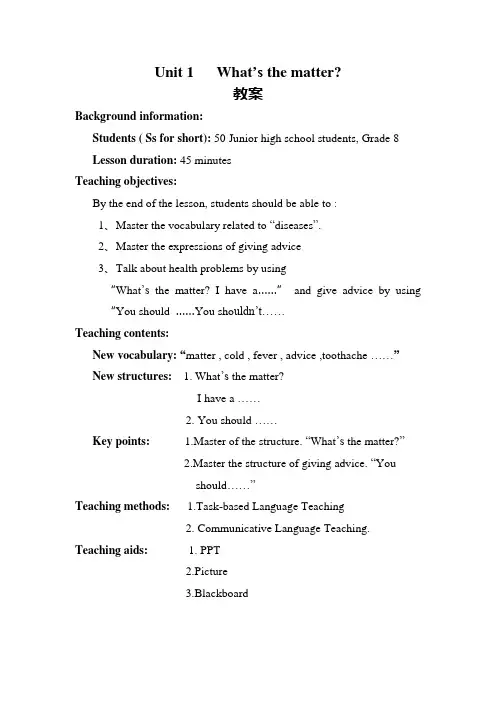
Unit 1 What’s the matter?教案Background information:Students ( Ss for short): 50 Junior high school students, Grade 8Lesson duration: 45 minutesTeaching objectives:By the end of the lesson, students should be able to :1、Master the vocabulary related to “diseases”.2、Master the expressions of giving advice3、Talk about health problems by using“What’s the matter? I have a……”and give advice by using “You should ……You sho uldn’t……Teaching contents:New vocabulary: “matter , cold , fever , advice ,toothache ……”New structures: 1. What’s the matter?I have a ……2. You should ……Key points: 1.Master of the structure. “What’s the matter?”2.Master the structure of giving advice. “Youshould……”Teaching methods: 1.Task-based Language Teaching2. Communicative Language Teaching. Teaching aids: 1. PPT2.Picture3.BlackboardTeaching proceduresStep I . Warming up: Greetings (3mins)1. Greeting the whole class as usual.T:Good morning, class. What date is today?/what day is it today?S:……Step II. Lead-in: A English song(2mins)1. Listen to an English song: (using the PPT to play a song)T:First , let us listen to an English song and do some reviewabout the words that last lesson we have learned.Lyrics of the song:(Head and shoulder knees and toes).Head and shoulders, knees and toes, knees and toes.Head and shoulders, knees and toes, knees and toes.eyes and ears and mouth and nose.Head and shoulders, knees and toes, knees and toes.Step III Review (5mins)1. Introduce the word “head” and “headache”T:How many parts of the body can you speak? What is this?(pointto the head)S: ……T: Yes, very good. This is my head . we can use our head to( think )<T stop for a while and guide Ss to answer>Oh ,Butsometimes I have a headache.< T write the word “headache” onthe blackboard>2. Ss read the new words after T “head” and “headache”.3. Display the rest of words in the same way.< back---backache >< tooth---toothache >< stomach---stomachache >Step IV Presentation: The new words1.Ss read each of the new words after T three times.List of words: matter , cold , fever , advice ,toothache ……2.Check if Ss can read the new words by themselves correctly.3.Play the game : “High and low voice” to consolidate the new words.T:All the students close your book, let us play a game .If I say theword in high voice ,you should say the word in low voice. If I say the word in low voice, you should say the word in high voice. Let us see which students do it correctly and quickly.4.Read the new words together.Step VI New structure(12mins)1.Show a picture on the PPT and T point at the picture .T: Look at the picture ,there are some students in thedispensary .[dɪˈspɛnsəri] 医务室What’s the matter withthem?(反复强调what is the matter?) Who can tell meWhat’s the matter with them? Any volunteers? Ok ,you please!Chinese or English are both ok.S: ……T:Ok ,very good . Look at the first girl with red hair. What’s thematter with her?(In turn to asked each student's situation, so thatstudents can quickly master the structure “What’s the matter?”) S:……2. Give Ss a model of a dialogue .D: What’s the matter?S:I have a fever/cold/stomachache/toothache/headache.D:You should drink lots of water.S:Thank you.……3.Ask them to make a conversation according to picture.4.Explain the new structure .a). What’s the matter?是一个疑问句,用于询问对方的身体情况,也是医生询问病人的常用语。
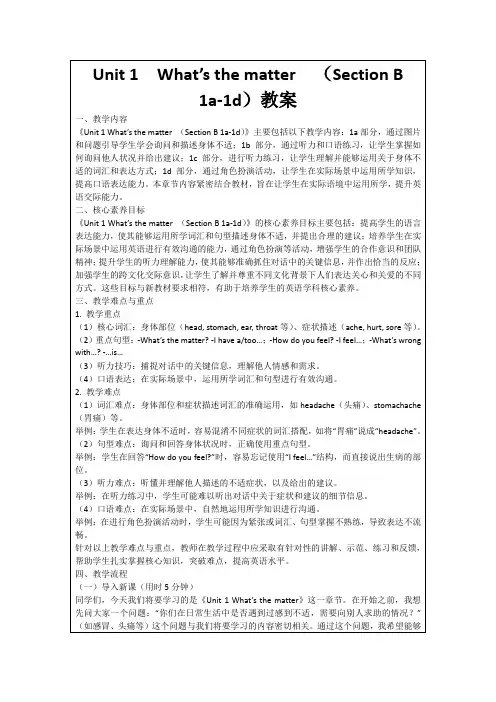
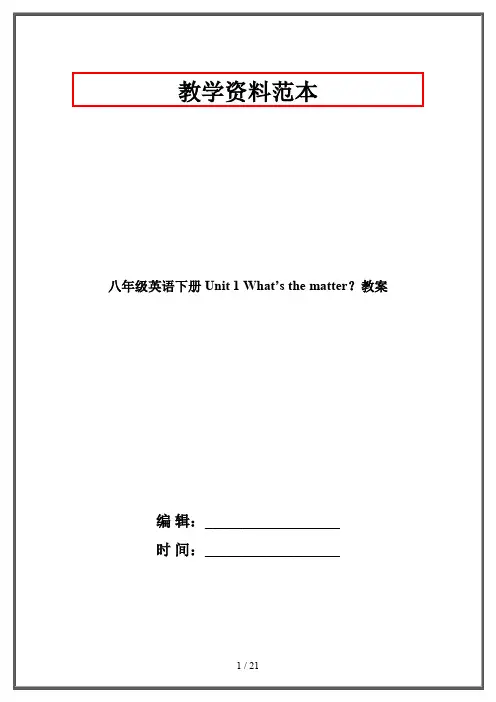
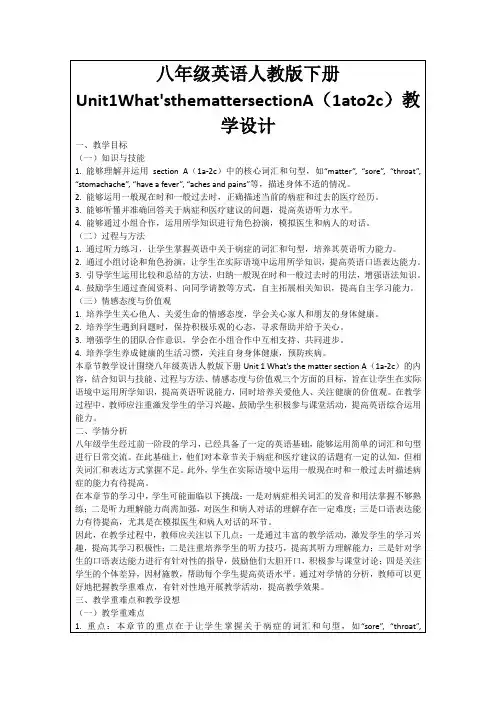
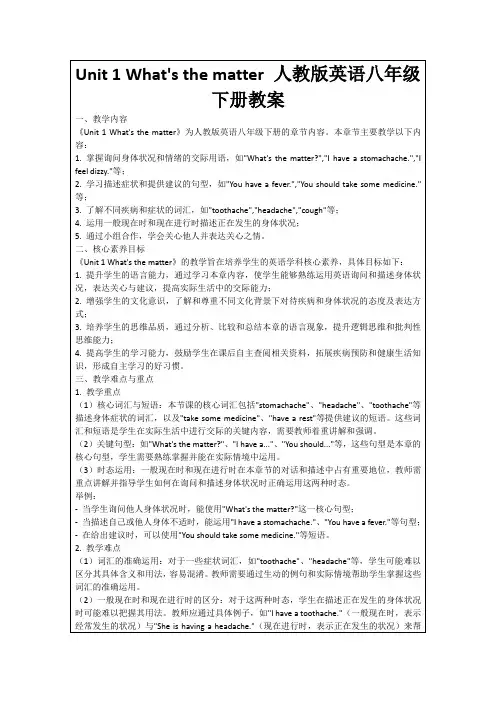
Unit 1: What’s the matter?Section A (1a-2d)Teaching aims(教学目标)1.Talk about health, problems and accidents. 2.Give advice.Language points(语言点)1.Words: parts of the body2.Sentences:I have a headache. You should go to bed.He has a stomachache.He shouldn’t go to bed.She has a toothache.She should see a dentist.Difficult points: How to talk about health problems and give advice.Teaching steps(教学步骤)1. Warm-up and review(课堂热身和复习)(1)New term greetings (新学期问候)T: Nice to see you again, everyone! All of you look so well. Did you enjoy your winter vacation?Ss: Yes.T: Can you tell me something interesting you did during the winter vacation?(老师可以鼓励学生给出尽可能多的答案)T: Oh. What an interesting vacation! I am sure you enjoyed yourselves very much, but I was ill during the holiday. Today, we’ll talk about “Unit 1: What’s the matter?”T: First, let’s review the parts of the body.Have Ss look at the picture and teach the new words.T:Let’s play a Bingo game.T: Let’s play a guessing game.教学设计说明:复习身体部位并通过游戏巩固,为完成1a服务。
2. Work on 1aT: Look at the picture. Write the correct letter [a-m] for each part of the body.教学设计说明:通过图片来检测学生对身体部位的掌握3. Presentation(呈现新知识)T: N ow, they are at the doctor’s. Let’s see. What is the matter with them? We can also ask, What’s wrong with them?T: (help Ss answer) He has a cold.T: W hat should he do?T: H e should take some medicine.(教师用同样的方法教授其他疾病及相关的建议:1.胃/肚子疼2.脖子疼3.头疼4.嗓子疼, 喉咙疼5.背疼6.感冒7.发高/低烧8.咳嗽9.牙痛4. Work on 1cPresent the picture and have Ss to do the pair-work. 总结各种疾病及如何给出建议和句型。
教学设计说明:通过用图片展示目标句型并进行总结,为后面的听力做准备5. Work on 1bT: Now you’ll hear a conversation. Listen for the first time and look at the picture, then write down the names.(教师放录音,因为对话简单教师可以在放完一遍录音以后就订正答案)T: Listen again and fill in the form.教学设计说明:通过附加的听力来检测学生对疾病的表达6. Work on 2a and 2b.T (telling Ss): Some students are talking about health problems and giving advice. Listenand number the pictures [1-5] in the orderyou hear them.(教师放录音,因为题目简单教师可以在放完一遍录音以后就订正答案)T:Listen and match the problems with the advice.(教师放录音,因为题目简单教师可以在放完一遍录音以后就订正答案)T (afterwards): Let’s fill in the blanks according to the information in the recording.教学设计说明:通过听力来检测学生对疾病的表达和如何提建议。
7. Work on 2cHave Ss make conversations using the information in 2a and 2b.8. Work on 2dRead the role-play in 2d out loud for the class, then have Ss answer these questions:1.What is wrong with Lisa?2.What did Lisa do all weekend?3. What does Lisa need to do?4. What should Lisa do if her head still hurts tomorrow?T: Role-play the conversation.T: Translate the phrases into English.1. 量体温2. 听起来像3. 远离电脑休息4. 同样的方式5.没有动6. 发烧教学设计说明:通过听力和情景反应来检测学生对疾病的表达和如何提建议。
HomeworkOral: Read aloud the new words learned in this lesson.Written: Write a conversation between the doctor and the patient.教学设计说明:巩固记忆。
Section A (3a-3c)Teaching aims(教学目标)1.Master the skills of reading.2.Master the important phrases.Language points(语言点)1. 看到一个老人躺在路的一边2. 紧挨着他的一个妇女3. 呼喊救命4. 没有权衡利弊5. 下车6. 有心脏病7. 带他去医院8. 期望乘客们下车9. 等下一趟公车10. 令他惊讶的是11. 搬那个人上了车12. 多亏了13. 及时14. 考虑他自己15. 考虑挽救一个生命Difficult points: Having the right attitude of helping others.Teaching steps(教学步骤)1. Review(课堂热身和复习)T: What did we learn yesterday?Have Ss review briefly.(老师可以鼓励学生说出尽可能多的答案)T: Oh. We learned a lot yesterday. Let’s translate the phrases.(老师可以让学生一个个说答案,说完后可能齐读,对学生掌握不好的,要重复)教学设计说明:复习第一课时的词组为后面的阅读打下基础。
2. Pre-readingT: present a picture)Ss, look at the picture. Can you guess:1. What happened to the old man?2. Whether the driver will save the old man?(老师可以鼓励学生多说,提高学生的口语)教学设计说明:通过展示图片来引起学生的兴趣,通过让学生猜测来提高学生口语,3. While-readingI.T: Now, let’s check your guesses. Turn to Page 3, skim the passage and answer the questions.1.What did the driver see when bus No. 26 wasgoing along Zhonghua Road?2.Thanks to whom, the doctor saved the man intime?在检测答案时,老师引导学生注意文章的头和尾。
II.Work on 3bAfter checking the answers, have Ss scan the passage and check (√) the things that happened in the story.教学设计说明:老师在检测答案时,引导学生注意文章的细节。
III.T: Let’s fill in the blanks according to thestory.Wang Ping, a bus driver, was going ______ Zhongshan Road when he saw an old man ______ the other side of the road. He stopped the bus without _______ twice. He got off the bus and asked the woman next to the old man _________ happened. She said that the man has a heart ___________ and should go to the hospital. Wang Ping told the passengers that he must _______ the man to the hospital. He expected the passengers to get off and ________ for the next bus. But to his ___________, they helped him move the man _______ the bus. ________ to these people, the doctor saved the man in time.IV. Work on 3c.T: Ask the students to discuss the questions in pairs.教学设计说明:由于第三个问题没有固定答案,所以先听学生说了自己的看法后,再进行总结。